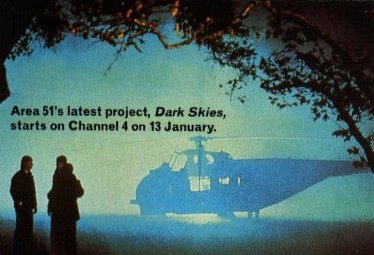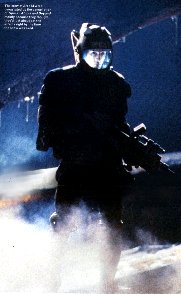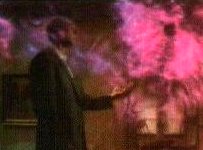With The X-Files, Space: Above And Beyond and Dark Skies, Area51 made a name for itself as one of SF TV's premier FX Houses, Jim Swallow talks shop with the Pasadena boys ...
 Compared to the secret military base stuck out in the Nevada desert,
Pasadena's Area 51 visual effects house is actually hard to find. Their
ads in Cinefex magazine quote the adress as classified and
a taxi driver, once full of pep and bluster, grows strangely quiet as
we cruise the roads looking for the location. Finally, he drops me off
at a non-descript grey building half hidden behind a cluster of trees.
It's only when I see a car in the parking lot with the license plate holder
"What matte line? That's a Shadow!" that I realise I'm in the right
place.
Compared to the secret military base stuck out in the Nevada desert,
Pasadena's Area 51 visual effects house is actually hard to find. Their
ads in Cinefex magazine quote the adress as classified and
a taxi driver, once full of pep and bluster, grows strangely quiet as
we cruise the roads looking for the location. Finally, he drops me off
at a non-descript grey building half hidden behind a cluster of trees.
It's only when I see a car in the parking lot with the license plate holder
"What matte line? That's a Shadow!" that I realise I'm in the right
place.
A small open-plan office module houses the hardware and talent that have made Area 51 a force to be reckoned with the TV SFX industry, winning them esteemed effects contracts with such major shows as The X-Files, Dark Skies, Millennium and Space: Above And Beyond. Like many other stealth facilities in Hollywood, if you don't already know where the place is, you shouldn't be there.
Visual effects supervisor Glenn Campbell later jokes about the site's location when a trio of producers ring the office to ask for directions. "I'll tell then how to get to Ron Thornton at Foundation Imaging for fun!"
Campbell is one of two head honchos at Area 51, the other being Tim McHugh, visual effects producer, and until its cancellation, co-producer of Space: Above And Beyond. "We're just far enough away for producers and directors to leave us alone," smiles Tim.
McHugh and Campbell are long-time compatriots, having worked in the movie industry for many years. "We come from a film background," says Campbell, "and we try to make everything we do here like it was shot on film. Tim and I also come from model effects backgrounds. We both started 17 years ago on Superman and met in the camera training program. Now there's not one visual effects technique we don't have hands-on experience of."
McHugh's opinions on the visual effects scenes are in keeping with Campbell's: "My background is traditional miniatures, but I find myself becoming more comfortable with computers. A couple of years ago, I'd have said, 'If you want spaceships, you can't use CGIs fly-bys; you use a high speed camera to make it look right.' Now I think the opposite, I've been converted.
Computers really are the future - the whole idea of what we're doing is trick photography, so the broader the brush the wider the range of techniques, and the better the final result."
Today the company's staff is spread across a handful of projects-in-progress. In the conference room, animation assistant Justin Hammond (sporting a Sapce: Above And Beyond T-shirt) works at a patch-up job the company has been handed for the X-Files fourth season premiere episode Herrenvolk.
Hammond runs video footage of actor Roy Thinnes back and forth, mapping wire-frame blocks over Thinnes and the surrounding scenery to a create a virtual version of the set in the computer's memory. Glenn Campbell takes a moment to show me the fruits of Justin's painstaking work - he rolls a tape of David Duchovny and Roy Thinnes running through an apiary, dogged by swarms of disturbed bees.
"These shots were filmed on a soundstage in Vancouver," explains Campbell. "What happened was that several hundred live drone bees were brought to the set, and parts of the walls and floors were coated with honey-like substance to attract the bees to them, so that the bees would fly around the actors while they were running away from the alien hitman (from the previous season's Talitha Cumi). But when they released the bees, a third of them flopped around on the floor and refused to fly, a third of them flew straight into the honey stuff, got stuck and died, and the remaining third flew out of an open window ..."
Campbell hits a switch and the bees vanish. "Every single bee in those scenes is computer-generated. We built a CGI bee in the computer and used a special behaviour simulation program to make them appear to be the real thing." Another click and the bees reappear ...
And you can't tell the difference as they hover and duck around Mulder's angst-ridden face. Hammond shows how the wire-frames covering the cast and scenery enable the computer to fly the bees around and behind moving objects or through pools of light as the camera tracks, even blurring correctly as a fast whipe pan occurs. While Justin (and the rest of the Area 51 team) are still a little sore after missing out on an Emmy Award just days earlier, life-like work like this will probably net them on next year.
Campbell confesses that much of his work in visual effects is like this: "It's probably not what SFX readers think it is. Most of the time we have to do small fixes, like the bees, or alter skylines in adverts. I get people sending me showreels of fantastic CGI starships and alien planets, but I have to tell them, 'That's great - but can you do simple, believable stuff?' We're all SF nerds here, and when we do spaceships and battles like in Space: Above And Beyond, it's great. But most of the time it's simple stuff that people don't even see."
As an example, Campbell describes another scenes from Herrenvolk, where Mulder fights with the hitman. "In the previous shot, he tells Roy Thinnnes to run off that way, but in the fight you can see him sitting in the car, watching them." This continuity error is dealt with by having the effects team simply wipe out the actor from the car in each frame of footage. Tim McHugh adds that elsewhere, someone's doing a similar job on the UFO series Dark Skies; the shadow of a palm tree is being erased from a building to make the LA location look more like Washington DC.
 Most of the magic that Area 51 works
comes from the source of most SF TV CGI effects, NewTek's versatile
Lightwave software which has been used in everything from Earth2
to Voyager, Campbell praises his competitors for their trail-blazing
work, in particular Ron Thornton and his team at Foundation Imaging
with whoom Area51 enjoy a friendly rivalry ...
Most of the magic that Area 51 works
comes from the source of most SF TV CGI effects, NewTek's versatile
Lightwave software which has been used in everything from Earth2
to Voyager, Campbell praises his competitors for their trail-blazing
work, in particular Ron Thornton and his team at Foundation Imaging
with whoom Area51 enjoy a friendly rivalry ... "While B5 is very stylised, [Foundation] got there first and they deserve the recognition and credit for being the guys who brouhgt CGI to television - no-oine had done it on that scale until Ron came along. We came along the same path, and the tools have been improved ..."
It's this commitment to building on what's gone before that enables a relatively small company like Area 51 to hold its own against giants like ILM, Sony Image Works and Digital Domain. "It doesn't make a lot of sense to build a physical model, especially when you're doing dogfights in space and that sort of thing. You build one model, you cna only have one stage with one team shooting it, unless you make duplicates. With a computer, once you've built the model, you go, copy, copy, copy, and you've got a fleet. Now you can have five guys working on five different shots using the same model."
CG animator David Jones works around action figures of The Tick and Manga dinosaur Gon as he slowly breathes CGI life into a spindly alien creature, a test sequence for NBC's new JFK/X-Files/Invaders hybrid Dark Skies. Jones is animating a Grey for possible inclusion in the season finale, but viewers of Space: Above And Beyond have already seen his hand in designs like the mammoth USS Saratoga spacecraft carrier. Scattered across his desk are numerous shots of the Dark Skies' alien make-up and maquettes, and leaning limply on a nearby pillar is the real thing - a four-foot high oddity made of latex foam.
Jones quotes the colossal numbers of polygrams that go to make the latex EBE's digital sibling, deftly toggling back and forth with the model, adjusting light sources and strengths for greater effect. The CGI alien stopframes through its motions, looking far more menacing than its slightly brown, rubber double. Dark Skies has already benefitted from the company's talents, the opening teaser of its pilot show The Awakening features a retelling of the Gary Powers' U2 crash in the '60's, with the spyplane running afoul of a giant UFO, all rendered (fittingly) by Area 51.
 Campbell takes pride in the meticulous
fine work Area 51 does on its virtual models. "We were very concerned
with Space: Above And Beyond that the ships look like models
more than computer images. We didn't use a lot of short cuts that oyu
tend to use with CGI, where you build a model and use various techniques
to render surfaces and add detail - in our case, we actually built the
model as it it were real, and treated it like that. Karl Denham [another
of Area 51's CG animators] textured the Hammerhead fighters; he went
through and textured each individual panel so they were custom-tailored
- one panel next to another didn't have the same amount of paint
on them, just like in real life. That's why you can get incredibly close
to the Hammerheads and the APC and they still look good."
Campbell takes pride in the meticulous
fine work Area 51 does on its virtual models. "We were very concerned
with Space: Above And Beyond that the ships look like models
more than computer images. We didn't use a lot of short cuts that oyu
tend to use with CGI, where you build a model and use various techniques
to render surfaces and add detail - in our case, we actually built the
model as it it were real, and treated it like that. Karl Denham [another
of Area 51's CG animators] textured the Hammerhead fighters; he went
through and textured each individual panel so they were custom-tailored
- one panel next to another didn't have the same amount of paint
on them, just like in real life. That's why you can get incredibly close
to the Hammerheads and the APC and they still look good."
After spending a while at Area 51, it's painfully clear the team mourns the loss of their (to date) best known work, Space: Above And Beyond. While all the staff are hard at work on new projects, everyone is disappointed at the show's cancellation and remembers it fondly. "We were just about right with hte show when it was cancelled," laments McHugh. "It took us a while to get things the way we wanted with the effects, and jsut when we got it they way we wanted, they stopped doing it."
McHugh's office sports one of Nathan West's flight suits from the piolot episode, while downstairs CG animator Scott Wheeler's corner of the room is decorated with vehicle designs from the show and a troop transporter insignia, grabbed off 58th Squadron's carrier before the sets were struck. Across from Wheeler, Wayne England's desk sports pictures of the Aerotech pleasure ship Bacchus, Star Wars blueprints, Dark Skies UFOs and storyboards from another of Area51's projects, the $28 million family adventure flick The Warrior Of Waverly Street.
Wheeler is noted for his work on many of Space's ship designs, including several of the alien Chig starships and the troop-carrier; his trademark is a visual gag inserted onto everything he deisgns - his wife's name, Lana. In the trade these bits of meaningless detail are known as nernies he tells me. "I don't think there's anything Scott's ever built that doesn't have her name on it," says McHugh. "The interior of the space freighter MacArthur (from the episode Mutiny) has her birthday as the cargo bay numbers!"
England (Who's English, natch) in particular feels that Space has showcased some of his best work, from the ice-ball comet in River Of Stars to his personal favourite in Level Of Necessity - "There's a shot about a third of the way through where we see the APC landing on the planet Daedalus, and I was really proud of the whole planetary shot. I built the planet, and we sae the spaceship going towards it. I built a full landscape, with atmosphere and a mist, and the APC flies over this terrain and lands [blending into a live action shot of the troops disembarking]. That came out well."
In addition to fabricating the spaceborne elements in Space, Area 51's deft touch can be seen in several striking composites with live action: subtle stuff like an alien bird in Who moniotrs The Birds, virtual sets in Eyes and Mutiny, right up to balls-out action in Sugar Dirt, complete with dive-bombing Chigs and exploding fighter craft.
"The live action plates were filmed with an orange filter for that show," explains England, "So we had to take our Hammerhead fighters in different places and areas to make it look like they were really there with the actors. That took a long time to achieve."
In fact, the team were taken with the show that they were reluctant to commit to film one scene from the final episode, which showed one character's ship getting destroyed. In the end, the sequence shows part of the vessel spinning off into space, leaving a slim chance of survival. Bless'em.
 As the day draws to a close, the team
gathers in the conference room to review the work in progress - the
dailies. The bee shots for The X-Files are still under construction.
So are two shots for Dark Skies. First up is a brief sequence
illustrating the aliens are already here subtext of Dark Skies.
Actor JT Walsh tells hero Eric Close that the Greys are coming, and
offers proof. He taps something out of a metal container, and it floats
around the room. England solicits comments from his team-mates as the
unfolding sequence runs in a loop. McHugh thinks it spins too fast,
and Jones wonders if an energy wave effect might improve it ... England
takes notes and considers improvements while Jones shows off the latest
draft of his pet alien, which rises up from a crouch to stare, glassy-eyed,
into a camera and raises its bony hand.
As the day draws to a close, the team
gathers in the conference room to review the work in progress - the
dailies. The bee shots for The X-Files are still under construction.
So are two shots for Dark Skies. First up is a brief sequence
illustrating the aliens are already here subtext of Dark Skies.
Actor JT Walsh tells hero Eric Close that the Greys are coming, and
offers proof. He taps something out of a metal container, and it floats
around the room. England solicits comments from his team-mates as the
unfolding sequence runs in a loop. McHugh thinks it spins too fast,
and Jones wonders if an energy wave effect might improve it ... England
takes notes and considers improvements while Jones shows off the latest
draft of his pet alien, which rises up from a crouch to stare, glassy-eyed,
into a camera and raises its bony hand. The massed Area 51 squad cram into the room on sofas, chairs or propped against the door.
"Dailies rule here," says Campbell. "The highest accolade you can get is when someone says, 'That's great!' and worst is when you realise that the shot is not working. We have a code for shots like that - MNS, which means Make Not Suck!"
Wayne seems happy to get his co-workers' input. Certainly, the chummy FX Men Behaving Badly feel of Area 51 is positive. "If we worked at ILM, our kind of in-joke humour might not find its way in," reckons Wayne.
On on wall, a large wipe-board displays the shot listings for The X-Files, Dark Skies and the next project in line, G[e]henna, an episode of Chris Carter's new drama series Millennium. Once a given sequence has met with the approval of all present, it's checked off with a coloured dot and the staff move on.
I'm about to move on myself when I realise that I'm stranded. No cab company run out here. But I'm saved when Glenn kindly finds me a lift back with one of the crew. As we pull out of the car park, I take a look behind us in the mirror at the building, but like those bees, one mooment it's there, the next ...
All site graphics, original texts, and content other than specified © DrkNite. Fan art, fan photos, and other contributed materials © to their respective owners. All rights reserved.